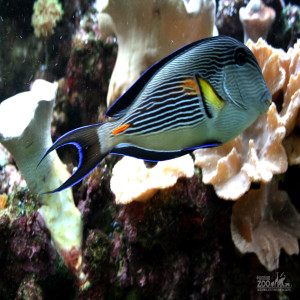 The sohal surgeonfish or sohal tang can grow up to 16 inches in the wild. Its striking blue and white horizontal stripes have made it what many consider the ‘poster fish’ for the Red Sea reef environment. Like other tangs, the sohal tang is compressed laterally, making it extremely maneuverable and fast along the reef. It has a horizontal, blade-like spine along the base of its tail on both sides, which folds into the fish, pointing anteriorly towards the head. During defense and aggression, tangs flick the spine at other fish or intruders, causing physical harm, but are non-venomous. The surgeonfish are named for this scalpel-like spine. They are vulnerable to parasites. This fish has been known to live up to 10 - 15 years.
The sohal surgeonfish or sohal tang can grow up to 16 inches in the wild. Its striking blue and white horizontal stripes have made it what many consider the ‘poster fish’ for the Red Sea reef environment. Like other tangs, the sohal tang is compressed laterally, making it extremely maneuverable and fast along the reef. It has a horizontal, blade-like spine along the base of its tail on both sides, which folds into the fish, pointing anteriorly towards the head. During defense and aggression, tangs flick the spine at other fish or intruders, causing physical harm, but are non-venomous. The surgeonfish are named for this scalpel-like spine. They are vulnerable to parasites. This fish has been known to live up to 10 - 15 years.
Location: Animals Formerly at Zoo
Share:
Range
Red Sea & Persian Golf
Habitat
Habitat includes reef environments in the Red Sea, to 90 feet or deeper.
Conservation Status
Vulnerable
Primary Threats
Human Wildlife Coexistence, Climate Change
Gestation
The gestation time is not known for this species. The breeding is tied to lunar cycles.
Litter
Since hundreds of gametes are sent into open waters where they scatter, it is hard to give a number as per each breeding.
Behavior
Sohal tangs are one of the more aggressive tangs, and combined with its large size for a tang, are a dominant fish along the Red Sea reef. Sohals are known to be alert and curious, constantly swimming, and yet can show aggressiveness to other fish around. They are a constant grazer which will scrape off marine algae when found. Sohals in adulthood are solitary and very territorial.
Reproduction
Sohals reproduce by congregating in pairs tied to lunar cycles, releasing floating gametes.
Wild Diet
Primary diet consists mostly of vegetable matter, but occasionally includes the flesh of other animals. Sohal tangs have been known to nip at clam mantles and soft large-polyp and small-poly stony corals.
Zoo Diet

